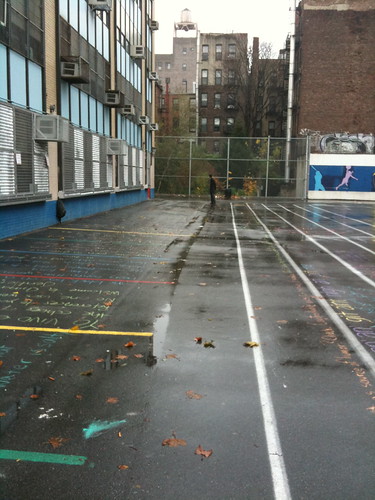Thursday, November 26, 2009
Happy Thanksgiving!
Saturday, November 21, 2009
Dems Proceed on HCR09 + US in Shambles + Blade Closes + Partió Blas Jiménez
Perhaps it has often, if not always, been this way, but the close-but-unfinished health care reform effort, the ongoing wars and related national security issues, and the economic crisis all throw into high relief how ineffective the United States' upper house continues to be. That said, it increasingly looks like the Democrats will pass a health care reform bill that, while not perfect, will be better than earlier indications suggested. Though the single-payer option is going, the final bill probably will have a public insurance plan; it probably will allow people to opt out of terrible current plans instead of being locked into them; it probably will provide adequate subsidies for a sizable portion of working- and lower-middle families; and it will stop insurance companies from some of their worst practices, such as dropping people because of "pre-existing" conditions, jacking up rates when people get sick, and turning the entire process of dealing with the health care system into a free-for-all lottery. The Senate bill, like the House bills, also includes horrendous anti-immigrant and anti-reproductive rights provisions, and it does not adequately address the for-profit nature of the system, which means that US consumers spend anywhere from twice to three times as much per capita per year as our industrialized peers, and it doesn't have enough in it to drive down insurance costs or drug prices, another baleful aspect of the current American healthcare landscape.
As the bill undergoes continual weakening and diminishment, it makes me wonder whether the Democrats, despite getting so far, will be able to pass it, either by majority with or without a single Republican vote, or by reconciliation, thereby taking a page from the GOP, and if they do so and President Obama in the end signs it, whether it will anything more than a mostly hollow victory. Continual public pressure on the Congress seems to be the only way ensure even minimal fidelity to the people's business, so you know what we all must do:
Call/write/fax your Representative
Call/write/fax your Senators
Urge everyone you know to do so to. Now is a very perilous period for the health care reform bill, and anything progressive.
===
Things are really grim economically across the US and much of the world; this isn't news. I see and feel it in varying ways, and often have to force myself not to dwell on how it's affecting so many people I know well, as well as those I don't. Then I read an article like the ones below and I start to feel more than a little worried; things are much, much worse than they seem, and yet the people running the government, corporate heads, the mainstream media all seem so blasé, indifferent, or incapable to getting their acts together.
Alternet.org: 15 Signs the Country Is Coming Apart at the Seams
Longer piece: Amped Status: The Critical Unraveling of US Society
Despite all the grim indicators--including the 123 banks that have failed so far this year--believe the country will turn around, but given the approach of those leading the government and many corporate leaders, it's going to be a painful process, and there's no guarantee that we won't be even worse off if the main perpetrators--their enablers remain in power--behind the mess we're in somehow inveigle their way back to full power using false-populism, lies, propaganda, and anything else that works.
One issue I've thought about a lot is the Congress's inability to reform the financial industries or sector. One key issue is the "too-big-too-fail" problem. As I've mentioned before on this blog, my first post-undergrad job was in banking, when commercial and investment banks were forbidden by law from merging or sharing certain key functions, when banks could not operate across state lines, and when certain other regulatory controls dating from the period of the New Deal were still strongly in place. Even with those safeguards, in October 1987, one month after I began my very brief banking career, stock markets across the world witnessed their biggest crashes in decades. This was also during a period when the US dollar was comparatively weak, and the country was struggling with the deficits that had built up during the previous 8 years of massive tax cuts, defense spending binges, rising deregulation, and gross underinvestment in public and private infrastructure. The US had seen two recessions under Reagan, I believe, and would see an even worse one in a few years under HW Bush. And yet a little over a decade later, in the late 1990s, after the economic upswing, financial policymakers led by Robert Rubin and Larry Summers would do everything they could to gut what remained of the New Deal safeguards, working hand-in-glove with people like Senator Phil Gramm (R-TX) to repeal the Glass-Steagall Acts of 1932 and 1933, which had maintained one of the last walls prevent a return to 1920s-style laissez-faire capitalism. Many of these policymakers and their adepts are in place today; we have a libertarian Republican as Fed Chair. We have a neoliberal centrist from the Rubin school, who made disastrous bets at his previous job, coordinating economic policy for the administration. We have a lackey for longtime financial megagambler Goldman Sachs as Treasury Secretary. The already big banks are considerably bigger, and several will be handing out more in bonuses--record bonuses--this year than some states' budget deficits. How it all will shake out, I don't know. But as the Alternet piece suggests, things are pretty grave and could get ugly. Very, very ugly. I hope and pray they won't.
===
 I recently participated in some heavy backchannel lamenting about the collapse of the Washington Blade, one of the nation's premier LGBTQ newspapers which had just celebrated its 40th birthday; its sibling newspaper, The Southern Voice in Atlanta, and of its parent company, Window Media, the owner of several other LGBTQ-focused newspapers and periodicials in the country.
I recently participated in some heavy backchannel lamenting about the collapse of the Washington Blade, one of the nation's premier LGBTQ newspapers which had just celebrated its 40th birthday; its sibling newspaper, The Southern Voice in Atlanta, and of its parent company, Window Media, the owner of several other LGBTQ-focused newspapers and periodicials in the country.The culprit, from what I can tell, is the current dismal economic environment. Several publications in New York and other cities have also fallen by the wayside over the last year. I agree with the argument that with the ongoing development of the Internet and new online media have come a range of new means for disseminating news, conducting investigations, and fostering advocacy and knowledge production around LGBTQ issues, but I also think we shouldn't underestimate the value and necessity of traditional news organizations, including the much smaller but once vital issues and identity-oriented ones, like the Blade. It and newspapers like it have played and continue to play an important role especially during a period when some certainties about how far the society has shifted on LGBTQ and other issues are being called into question. At her David R. Kessler lecture several weeks ago, Sarah Schulman noted, among her many wise points, that "we are dismantling" many of our longstanding institutions--or we are allowing them to be dismantled--at the very moment that we may need them more than ever. Perhaps these vivid manifestations of ongoing struggles remind us that we aren't yet in the post-everything (post-gay, post-race, etc.) worlds that have been proclaimed for quite some time.
Some articles suggest that the Blade may resume publication under different auspices, perhaps as an employee-owned paper or as a not-for-profit, the latter being a model I'm surprised isn't discussed even more as journalism in general takes hit after hit.
===
 A friend, translator, scholar and librarian Herbert R., recently sent word of the passing of one of the Dominican Republic's important poets, Blas Jiménez (at left), on November 13. One of the most stalwart expositors and champions of the DR's African heritage--90% of Dominicans have African ancestry, a higher percentage than almost every other country in the Americas except Haiti, Jamaica, and the predominantly Black Caribbean islands--Jiménez had a rich and varied career, as an award-winning journalist; essayist; professor at the Pontificia Universidad Catolica Madre y Maestra; TV producer and host of Página Abierta, radio producer and host of La Mañana en Antena; as Secretary General of the DR's national commission for the United Nations Organization for Education, Culture and Communication (UNESCO). For over a decade he worked at the International Education Resource Center, where he developed courses on Afro-Dominican and Caribbean culture and literature.
A friend, translator, scholar and librarian Herbert R., recently sent word of the passing of one of the Dominican Republic's important poets, Blas Jiménez (at left), on November 13. One of the most stalwart expositors and champions of the DR's African heritage--90% of Dominicans have African ancestry, a higher percentage than almost every other country in the Americas except Haiti, Jamaica, and the predominantly Black Caribbean islands--Jiménez had a rich and varied career, as an award-winning journalist; essayist; professor at the Pontificia Universidad Catolica Madre y Maestra; TV producer and host of Página Abierta, radio producer and host of La Mañana en Antena; as Secretary General of the DR's national commission for the United Nations Organization for Education, Culture and Communication (UNESCO). For over a decade he worked at the International Education Resource Center, where he developed courses on Afro-Dominican and Caribbean culture and literature.Amidst all of this great work, he was also and perhaps best known as a poet, and especially as a "poeta de negritud." His works include the volumes Aqui... Otro Español (Here...Another Spanish), Caribe Africano en Despertar (African Caribbean Waking Up), Exigencias de un Cimarrón (Exigiences of a Maroon), and El Nativo (The Native). With highly regarded scholars Silvio Torres-Saillant and Ramona Hernández, he co-edited the book Desde la Orilla: hacia una nacionalidad sin desalojos (From the Edge: Towards a Nationality Without Evictions). His death, as this very brief note makes clear, is a major loss for Dominican, Caribbean, and African Diasporic literature and culture.
Friday, November 20, 2009
iDrawings (New Batch)
Click on any for larger images.
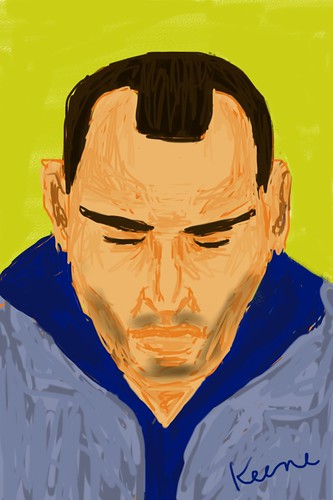
Man on subway (I must draw these quickly, since I only have 2 stops from 42nd St. to 23rd St. on the F or V, or 3 stops from Fulton to Grand Central terminal on the 5 or 6, and the latter train is always horribly crowded and people do not take kindly to being viewed intensely, another way of saying "ogled," even if for drawing purposes)
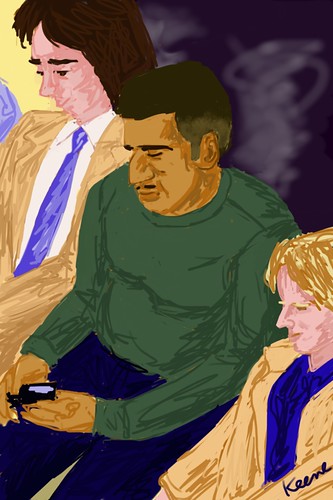
Group portrait, on PATH (the first group drawing I've done)

Man on PATH
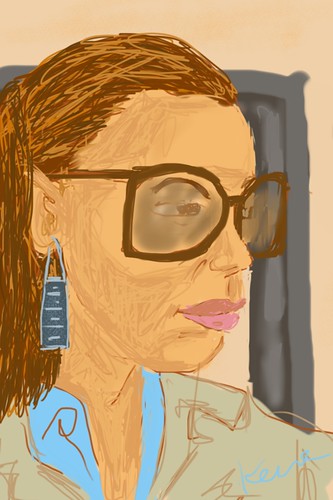
Woman on PATH (she kept giving me death stares, as if to say, you had better NOT be taking my picture--and I wasn't)
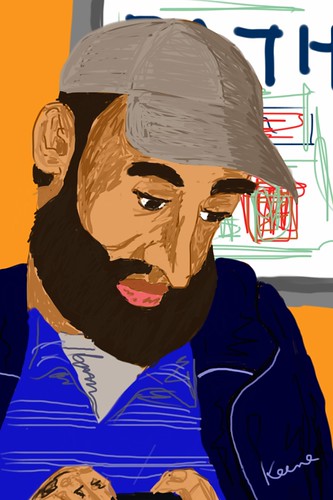
Man on PATH (I don't think he ever noticed I was drawing him at all)

Man on light rail
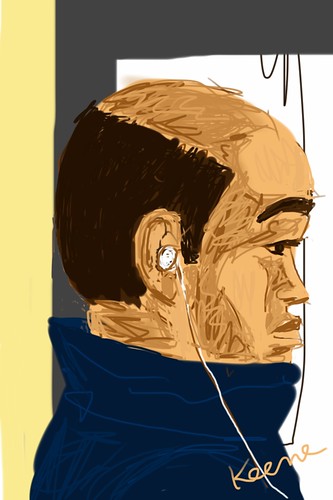
Man on light rail
Sunday, November 15, 2009
Tan Lin's Chalk Playground, LitTwitChalk

Performa 09, the biennial performance festival, has been taking place since the beginning of the month, and having missed the entire program in previous years, I've wanted to catch at least a few of the events, which include performances by the likes of Mike Kelly, Joan La Barbara, Adam Pendleton, Pauline Oliveros, Arto Lindsay, Dominique Gonzalez-Foerster & Ari, and many others, so yesterday, despite the rain (from the nor'easter), I ventured over to the Lower East Side to catch, and participate, in artist and poet Tan Lin's Chalk Playground, LitTwitChalk.
The event took place in and on the concrete playground of PS 2, on Madison Street just off Allen Street, on the edge of Chinatown and in the shadow of the Manhattan Bridge, and involved a live street-chalking exercise, followed by Tan's and others' chalking of a Futurist manifesto, a Chinese manifesto, and a collaborative, and real-time poetry “line” installation piece and drawings by a wide array of writers. Since I'm rarely in this part of Manhattan, I found getting there like navigating a maze, which included a sidetrip of one stop into Brooklyn before I switched trains and reemerged from the subway essentially right where the PATH had let me out, just one block north of Ground Zero and the WTC site. My iPhone's enhanced GPS mapping system proved very handy (the pulsating dot that moves as you walk is entrancing too), and I eventually found the site, though the rain had begun to drench the pavement, though not the chalkwork, and a number of participants were still there, including Tan.
On the Performa site, Tan listed, among others, Felix Alarcon, Bruce Andrews, Anselm Berrigan, Jimbo Blachly, Lee Ann Brown, Ethan Bumas, Greta Bumas, Emilie Clark, Yina Chun, Kareem Estefan, Robert Fitterman, Sarah Gambito, Kenneth Goldsmith, Paolo Javier, De-Quan Jenkins, Ahn Lin, Joseph Legaspi, Saqub Naeem, Jason Perry, Elizabeth Sanchez, Brittany Sanders, Katherine Sanders, Olivia Shao, Phillippa Shao, Lytle Shaw, Jennifer Tsuei, Charles Yarbrough, and Helena Zhang. I saw of few of these writers and artists, as well as Gordon Tapper, above whose extended, multicolored line I, at Tan's invitation, chalked in one. (See video below).
I plan to revisit the site later this week, just to see how the chalking has held up. After several days of rain, and later tires and children's feet, it probably will be a blurry mess, but the collaborative, outdoor aspects of it, as well as its ephemeral nature, made it a lot of fun, and a great deal of the statements were thoughtful and provocative. I hope Tan does this again, on heavily trafficked sidewalks in parts of the city where the messages may spark immediate thought and commentary among passersby.
Some photos:
Tan Lin observing some of the handiwork
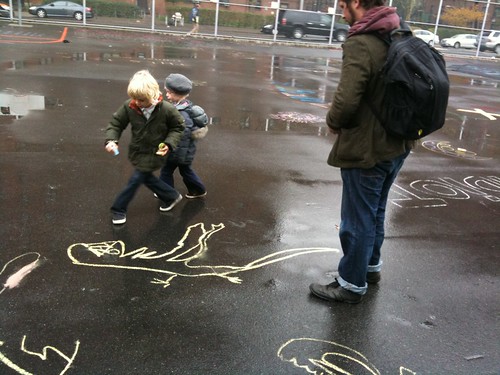
Little artists participating in the event
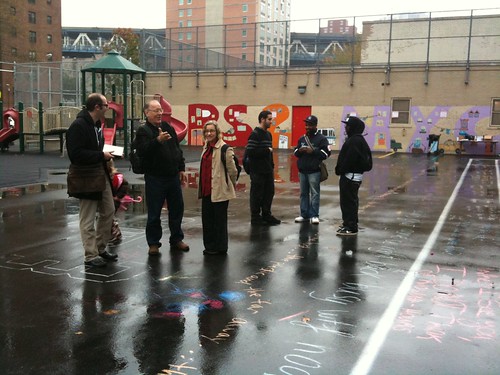
Participants chatting (Bruce Andrews in all black)
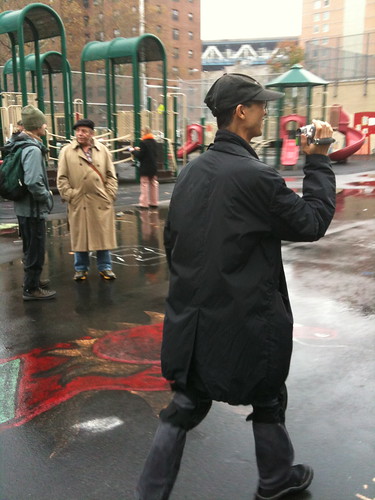
Lin videorecording some of the work (Pierre Joris in the trenchcoat and beret)
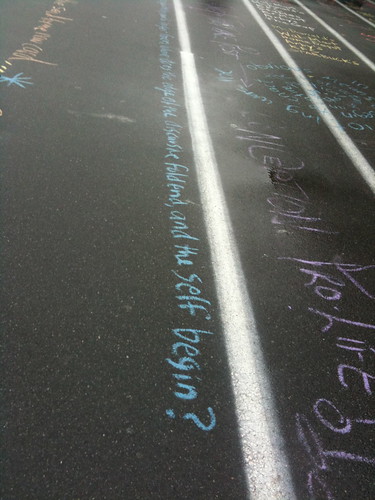
My first line
YouTube video I made of the first line I chalked (very short)
A video of one of the collaboratively chalked pieces (very short)
Thursday, November 12, 2009
Ernest Hardy Interviews Sapphire + Tayari Jones & Breadmaking
***
Continuing on the Precious tip, Tayari Jones recently noted on her blog that the controversy swirling about the film had gotten to her so much that she decided to bake a 7-Up pound cake--and she posted the recipe on her blog. (I am going to have to try it.) It looks delicious enough to calm anyone facing anything.
(BTW, Congratulations to Tayari also for having her new novel picked up by Algonquin Books!)
I can't claim similar grounds for my baking, but I do look forward to any excuse to create a loaf of bread. I don't know what is going on with this bread-baking mania, but I really enjoy doing it, and it really calms me down. I did finally make one of the bread recipes Miriam sent, for Irish soda bread--and then turned what was left of it into bread pudding with chocolate that was one of the best desserts I've made in some time. But before I post that, I'm going to post the basic bread recipe from which almost any standard loaf can be made.
I should add that a number of people I know either can no longer eat bread--at least store-bought bread--or deign to for dieting purposes, but I wonder if this homemade bread has the same effect. Recently when we had gone through several micro-sized baguettes I baked C bought some bread from Calandra's Bakery, and it molded after about 4 days (!?), while other store-bought bread--baguettes, Italian bread, etc.--turns to stone if left out of the refrigerator. The bread I bake 1) usually keeps for a week without mold if not refrigerated; 2) retains its flavor for weeks, even if refrigerated; and 3) maintains its consistency as well. I wrote to Calandra's to let them know about their bread, but I got a very terse, robotic response from some PR person, so if you're in northeastern New Jersey and shopping for what you think is homemade-style bread, you've been forewarned.
The Basic Recipe
I adapted my basic recipe from Mark Bittman's New York Times "no knead" recipe. It's a better bet than his book, How to Cook Everything, which is excellent but unaccountably uses "pounds" instead of "cups" for the basic recipe, which causes unnecessary confusion. There are several keys to getting consistently good bread with this recipe, I've learned. First, you should always use rapid-rise yeast. Second, mix the flour in a glass bowl, then cover it with a plastic shopping bag (which increases the heat and moisture in the bowl and yeast growth) held in place by a rubber band--it's far more effective than a loosely draped tea towel, a cutting board, etc. Third, keep the covered bowl in a warm part of your kitchen. Fourth, always use a little olive oil during the second (even if brief) knead period. It is essential to prevent the dough from sticking or burning, and it adds flavor.
Okay, so here goes. You start with:
1 packet of rapid-rise/quick-rising yeast (VERY IMPORTANT)
2 teaspoons of salt (Bittman says 1.5, but 2 give more flavor)
3 cups of bread/unbleached flour/whole wheat/rye flour
1/2 cup of pastry flour (VERY IMPORTANT)
1 1/2 cups of water (you can often use a little less but adjust according to the dough's consistency)
C figured out the pastry flour addition. It is essential because pastry flour has LESS gluten and is lighter than regular flour, so when the dough rises, it adds more air bubbles. Do not use self-rising flour, cake flour, or other kinds of prepared flours. Some combos to try are:
1) 3 cups of unbleached whole wheat bread flour + pastry flour = French/white bread
2) 3 cups of unbleached general purpose flour + pastry flour = French/white bread
3) 1 cup of stone ground whole wheat flour + 2 cups of unbleached whole wheat bread flour + pastry flour = lighter whole wheat bread (hearty)
4) 3 cups of stone ground whole wheat flour + pastry flour = fuller whole wheat bread (VERY hearty)
5) 3 cups of whole rye flour + pastry flour = rye bread (and darker than rye bread that you buy in the store--EXTREMELY hearty)
And so on. The proportions are key, and the heavier the basic flour (rye, whole wheat), the more important the pastry flour.
To start, you pour the yeast and salt in the bowl, then add the flour. I either gently stir or whisk these together to ensure that everything is well distributed. Then you slowly add the water. It may not seem to be binding into dough at first, but keep stirring and folding it, with a wooden spoon (you could use your fingers as well), and you will see that it starts to become shaggy, then more of a ball. I suggest not adding all the water if you can; you don't want the dough to be a wet mess, just moist. If it's too wet, then add a little more flour. But if it appears too dry after you'd added the suggested amount of water above, then add a little bit more water so that you can at least pull it from the sides of the glass. Create a little ball, and then cover it with a plastic bag (the basic supermarket ones are great), holding it in place with a rubber band. You don't want any air to get in or out. Let it sit for 3-4 hours. You could create it in the morning before work, and it'll be ready when you get home. It also can sit for longer (6-7 hours, etc.).
NOTE: Rye bread does not rise as much as other kinds of bread. Bittman says it barely rises at all, but with the pastry flour, mine does expand a bit. So don't be dismayed if it doesn't puff up like wheat/white bread.
After the dough has sat for the necessary amount of time and risen (you will see it double or sometimes triple in size), you want to pull it out and on a clean, lightly oiled (olive oil) cutting board, press it down and fold it into itself several times. I always do this by hand. Do not overknead it, but perhaps turn it into itself about 10 or so times. This is the stage at which you can add raisins, nuts like pecans, walnuts and pignoli, olives, herbs like rosemary or chives, garlic, chunks of sun-dried tomato, anything. I have tried many of these. The key is to make sure they're not oily or wet (so wash the pitted olives well and dry them). When you've kneaded or added ingredients and kneaded the dough, form it into another ball and return it to the plastic bag-covered bowl. Let it sit and rerise for another 1/2 hour. (You could let it sit for longer if you like, but usually 1 hour max is great.)
Now comes another important step. As the bread is rerising, you should turn the oven on and set it to 450°. If it takes your oven a while to warm up, start as soon as you return the dough to the bowl. If it warms up quickly, you can do this about 15-20 minutes before you bake the bread. You want the oven HOT, though, when the bread goes in. About 10-15 minutes before you bake the bread, you should put whatever you're baking the bread in or on--an ovensafe covered crock/French pot, a baking sheet, a bread stone--into the oven so that it warms too. I either use a covered crock pot or a baking sheet, depending upon the bread I'm making. Neither needs to be oiled because you've already oiled the bread, and loose oil in a crockpot or on a baking sheet will begin to smoke...bad news!
When the bread has sat for at least 1/2 hour and rerisen, remove the plastic-bag cover. Then remove the crock pot/baking sheet/bread stone and set it atop your stove. You should carefully place the rerisen dough into the crockpot (and cover, to keep the steam in, which will make the bread light inside and hard outside) or onto the baking sheet/bread stone. Form it into a boulle or round loaf, or stretch it out if you want a longish loaf. (For baguettes, break it into two pieces and stretch them out. Put it back into the 45o° oven and let it cook for 30 minutes. (During the baking process, you can gingerly score the top with a knife if you want to be fancy.)
If you put it in a crockpot, remove the pot top (a palindrome!) after 30 minutes, and let the bread bake uncovered for 15 more. It should be light/golden brown on top. If you cook it on a baking sheet, it will also be golden brown, but the crust won't be as hard. The trick to getting a harder crust if you bake the bread on a baking sheet is when you initially put the baking sheet in the oven, to place a pan underneath it, let it heat for a little bit, then CAREFULLY add water so that it steams. You can also spritz (or use your fingers to sprinkle) water on the hot insides of the oven and on the baking sheet to create steam. This creates a hard crust, and is essential if you're making baguettes.
Also, be VERY CAREFUL when spritzing not to splash water on the oven's light bulb. Why? Because it explodes! I can attest to how difficult it is to clean up the broken glass, and to having to throw out the bread for fear it's been pierced by glass shards. Not fun.
Remove the bread after more 15 minutes or it's browned on top. You don't want it to burn. Place it on a cutting board and let it cool to room temperature. Don't cut it right away, but let the inside cool. After about 5-10 minutes, if you want to try some with butter or olive oil, or something else, you can sample it. To keep it for a week, you just place in the same sort of plastic shopping bag you used to cover the rising dough, and let it sit out at room temperature. If your home (apt./house) is really warm, then refrigerate it after a few (2) days, but if not, it should keep for 5-7 days without refrigeration.
And that's the basic bread recipe! I'll post one for semolina bread, and one to make pumpernickel bread, very soon. Both are similar but involve a few more steps/tricks.
Some bread photos:

Olive loaf

Rye bread, cooled and sliced

Pumpernickel bread (first time--I added too much molasses, so it was too sweet and crumbly. The second time I got the amount right. Recipe coming soon!)

Two mini-baguettes

My standard pecan loaf

Semolina loafs

Bread pudding, made with leftover Irish soda and chocolate
Wednesday, November 11, 2009
White on Precious + College for Fewer + CC Reading + AAWW Awards
 I haven't seen Precious yet. I'm torn; on the one hand I feel I ought to see it, and on the other hand...I recall Sapphire's extremely disturbing book, Push, which it took every fiber inside me to get through. (And yet the other night Mariah Carey told Larry King she read it twice. Really? Okay.) I had some issues with the novel, but on the whole I felt the author was telling a story that she felt needed to be told, even if it often felt gut-gnawingly wrenched from deep inside (if not her, then someone else.) The book and film, I recognize, are different. Entertainment titans Tyler Perry and Oprah Winfrey have gotten behind it, and the kudos from cinetomanes has been strong and sustained. A filmmaker I admire tremendously went to see it last week and tweeted his praise. Yet not everyone is agog over it. The New Yorker's Anthony Lane and New York Magazine's David Edelstein weren't sold. And there's always Armond White, in the New York Press, to challenge the cheering chorus. His review is titled "Pride and Precious," and it is an erupting volcano of critical vehemence. Brotha ain't playing:
I haven't seen Precious yet. I'm torn; on the one hand I feel I ought to see it, and on the other hand...I recall Sapphire's extremely disturbing book, Push, which it took every fiber inside me to get through. (And yet the other night Mariah Carey told Larry King she read it twice. Really? Okay.) I had some issues with the novel, but on the whole I felt the author was telling a story that she felt needed to be told, even if it often felt gut-gnawingly wrenched from deep inside (if not her, then someone else.) The book and film, I recognize, are different. Entertainment titans Tyler Perry and Oprah Winfrey have gotten behind it, and the kudos from cinetomanes has been strong and sustained. A filmmaker I admire tremendously went to see it last week and tweeted his praise. Yet not everyone is agog over it. The New Yorker's Anthony Lane and New York Magazine's David Edelstein weren't sold. And there's always Armond White, in the New York Press, to challenge the cheering chorus. His review is titled "Pride and Precious," and it is an erupting volcano of critical vehemence. Brotha ain't playing:SHAME ON TYLER PERRY and Oprah Winfrey for signing on as air-quote executive producers of Precious. After this post-hip-hop freak show wowed Sundance last January, it now slouches toward Oscar ratification thanks to its powerful friends.Winfrey and Perry had no hand in the actual production of Precious, yet the movie must have touched some sore spot in their demagogue psyches. They’ve piggybacked their reps as black success stories hoping to camouflage Precious’ con job—even though it’s more scandalous than their own upliftment trade. Perry and Winfrey naively treat Precious’ exhibition of ghetto tragedy and female disempowerment as if it were raw truth. It helps contrast and highlight their achievements as black American paradigms—self-respect be damned.
And he continues:
Winfrey, Perry and Daniels make an unholy triumvirate.They come together at some intersection of race exploitation and opportunism. These two media titans—plus one shrewd pathology pimp—use Precious to rework Booker T. Washington’s early 20th-century manifesto Up From Slavery into extreme drama for the new millennium: Up From Incest, Child Abuse,Teenage Pregnancy, Poverty and AIDS. Regardless of its narrative details about class and gender, Precious is an orgy of prurience. All the terrible, depressing (not uplifting) things that happen to 16 year-old Precious recall that memorable All About Eve line, “Everything but the bloodhounds nipping at her rear-end.”
It starts with the opening scene of Precious’ Cinderella fantasy. Tarted up in a boa and gown, walking a red carpet light years away from her tenement reality, Precious (Gabourey Sidibe) sighs, “I wish I had a light-skinned boyfriend with nice hair.” Her ideal smacks of selfhatred—the colorism issue that Daniels exacerbates without exploring. He casts light-skinned actors as kind (schoolteacher Paula Patton, social worker Mariah Carey, nurse Lenny Kravitz and an actual Down syndrome child as Precious’ first-born) and dark-skinned actors as terrors. Sidibe herself is presented as an animal-like stereotype—she’s so obese her face seems bloated into a permanent pout.This is not the breakthrough Todd Solondz achieved in Palindromes where plus-size black actress Sharon Wilkins artfully represented the immensity of an outcast’s misunderstood humanity. Instead, Sidibe’s fancy-dressed daydream looks laughable; poorly photographed, its primary effect is pathetic.
It never lets up. In fact, the final paragraph includes a description that verges on being gratuitously cruel, even as it underlines a critique White has made more than once about other films that appear to traffic in the same toxic brew as this one.
So who knows, I may go see it. Or not. It would be great, however, to see some films and non-"reality" TV shows about middle and working-class and poor people, black, white, latino, asian-american, all races and ethnicities, that did not hinge on stereotypes, pathologies, criminal activity, and the like. Does anyone in Hollywood or New York or elsewhere in the US remember how to make those films anymore? (Or get financing to do so....)
Ishmael Reed mentions Precious in one of his harsh critiques...
UPDATE: Oh my! Reed goes even further, in "The Selling of Precious."
+++
So the Chronicle of Higher Education last week asked: Are Too Many Students Going to College?
I thought the question was, How Will Most Students Who Want to Go to College But Aren't Rich Going to Afford to Do So? (When I was a freshman, my total tuition, with room, board and facilities fees, was about $13,150. When I graduated four years later, it was around $16,145. Though I have paid off my student loans, it seemed impossibly exorbitant, especially compared to state universities, like my home one, where a year's tuition was around $3,300-$5,000 over the same period. This upcoming year my undergraduate institution's tuition, with room, board, and facilities fees, will be $48,868. Insane, even if students whose parents earn under a certain amount can essentially attend for almost nothing. My former home state's flagship public university's costs, for 2008-9? $20,600!)
In case you haven't seen it, how people with and without high school educations and college degrees are faring in the current economic environment.
+++
 Also taking place tomorrow, a Cave Canem event:
Also taking place tomorrow, a Cave Canem event:Angela Jackson & Patricia Spears Jones will be reading at Poets House!
Chicago-based poet Angela Jackson and New York City’s Patricia Spears Jones will read from their work and talk about their literary coming of age in the cities they call home. The Cave Canem Writers Foundation joins Poets House and Northwestern University Press in celebrating the launch of Angela Jackson's new and extraordinary novel Where I Must Go.
Thursday, November 12, 2009
7:00pm - 9:00pm
Poets House
10 River Terrace
New York, NY
Catch it if you're available!
+++
This weekend the Asian American Writers Workshop will host PAGE TURNER: The Asian American Literary Festival, in New York City. Events begin on Friday, November 13, with a cocktail party and gala dinner that will include special guest and Booker Prize-winner Michael Ondaatje, and the presentation of a Lifetime Achievement Award legendary Alfre A. Knopf Publisher and Editor-in-Chief Sonny Mehta
A full slate of readings, and the AAWW's 12th Annual Literary Awards ceremony will take place on Saturday, November 14, at the Powerhouse Arena in D.U.M.B.O., Brooklyn, at 37 Main Street.
This year's Asian American Writers Workshop Award winners and finalists:
The winner of the Twelfth Annual Asian American Literary Award in Fiction is Jhumpa Lahiri for her short story collection Unaccustomed Earth. The two finalists are Amitav Ghosh for Sea of Poppies and Ed Park for Personal Days.
The winner of the Twelfth Annual Asian American Literary Award in Poetry is Sesshu Foster for his collection World Ball Notebook. The two finalists are Monica Ferrell for Beasts for the Chase and Jeffrey Yang for An Aquarium.
The winner of the Twelfth Annual Asian American Literary Award in Nonfiction is Leslie T. Chang for her book Factory Girls: From Village to City in a Changing China. The two finalists are Kao Kalia Yang for The Latehomecomer: A Hmong Family Memoir and Kavitha Rajagopalan for Muslims of The Metropolis: The Stories of Three Immigrant Families in the West.
Congratulations to the winners and finalists!
Tuesday, November 10, 2009
Politics + Yankees Win! + Se Pone Blanco + Kessler Lecture, 11/12 + iPhone Drawings

(Click on table to enlarge)
˚˚˚
On Saturday, the House of Representatives made history by passing a Health Care Reform bill by a 220-215 margin. Only one Republican, Anh Joseph Cao (R-LA), who represents convicted Democrat Bill Jefferson's former New Orleans-area district, voted for the bill, while 39 Democrats, most Conservadems, a few ultraprogressives (Dennis Kucinich) voted against it. The historic legislation, ushered through by Speaker Nancy Pelosi (D-CA) and her leadership team, does include some great touches, such as removing the tax penalty for same-sex domestic partners on the same plan and a considerably weakened public option. It also will go a long way towards covering the majority of the 40+ million who do not have and cannot afford health care insurance. But doesn't allow for a single-payer system, and includes extremist anti-abortion language that could conceivably be used by insurance companies to deny coverage to women who have miscarriages. It also does little to address one of the major problems of US health care, which is we spend more than twice, and in some cases three times what nearly every other industrialized nation does on health care. That is to say, it does little to remove the profit incentive from health care insurance, or to help drive down the cost of pharmaceuticals, medical devices, or hospital care. President Barack Obama removed himself from the discussion several weeks back, and seems concerned only with having something to sign, as opposed to the best bill possible. Or perhaps it's Rahm Emanuel whose conservative pragmatism is guiding the White House's approach. It's hard to know, because the White House sends out so many conflicting signals and operates in such a frustrating passive-aggressive manner it's hard to know what the President and his administration really stand for. Such are vicissitudes of 11 months of Obamatude. Well, we did get Sonia Sotomayor, didn't we?
Now the bill heads to the graveyard of the popular will, the US Senate. Republicans are mostly united against anything approximating reform. The Democrats probably have 50 votes, now that Al Franken is finally seated and Teddy Kennedy's replacement, Paul Kirk, also is present, but the main issue is a cloture vote, and it's unclear whether nominal Democrats like Ben Nelson and Blanche Lincoln, or tantrum-throwing neocons like Joe Lieberman, will sustain a filibuster and prevent anything viable from coming to the floor. The Democrats have one of the wettest noodles leading them, if one can use the term, Harry Reid, who seems incapable of exerting any real power whatsoever. Dick Durbin of Illinois, second in command, seems to do little more than whine and beg, to little effect. It's beyond pathetic. In fact, Reid has even spoken recently of not getting anything to the floor before the end of the year! Meanwhile, the GOP, which is now witnessing its lowest level of voter identification in decades, makes threats, commands the media, and continues to draw stricter and stricter lines, all to the end of gumming up the legislative process and destroying our Hamlettian head of government and state. I'll say this: if the Democrats fail to push through a Senate bill, and if they leave in Bart Stupak's toxic anti-abortion amendment, they very well may have their "Waterloo," even if the President hangs on to middling popularity by the skin under his nails. They appear to want to fail, and they're doing nothing to prevent it. Meanwhile, as has been repeatedly noted, 45,000 people die each year from lack of health care insurance or inadequate coverage, and as someone who dealt with the health care industry extensively last year, I can say that the US's system is seriously screwed up and needs help, immediately.
˚˚˚
Friday I joined hundreds of thousands (a million?) people who crammed into the narrow streets of lower Manhattan to cheer on the New York Yankees, who won their 27th World Series. Responding to an online query, I predicted that the Yankees would win--against the St. Louis Cardinals, who were out after the first round of the playoffs. The Yankees had everything they needed, on the mound and in the field, including some production from the pulchritudinous but perplexing and scandal-plagued Alex Rodriguez for a change. Last year's champions, the Philadelphia Phillies, just could not crack Andy Pettitte or Mariano Rivera, or keep Hideki Matsui and Derek Jeter off the bases. With the Cardinals out, I followed--and watched, sometimes with C--most of the Yankees' games, and thought they'd pull off a 4-1 series in Philly, but the return to and victory in the Bronx only made the victory sweeter.
The parade was, in my experience, one of those rare times, like last November on Michigan Avenue and in Grant Park in Chicago, when vast throngs of people gather together and, because they're united in a common cause, they behave very well. Just a few days before, I'd told C about a near altercation I witnessed on the 5 train, in which a wacko ranted on about everything nearly bursting his rage-swollen head in support of another nut who ran his bicycle wheel over one woman's foot and into another's leg. On Friday, however, and I don't think it was just the presence of enough New York police officers to form a human bridge to Weehawken, people were acting quite kindly towards each other. I saw this again and again as people were polite when pressing through the dense crowds, and on the subway, there were more "Excuse mes" and "Pardon mes" than I've heard over the last 7 months. One unfortunate thought I had amidst all the good cheer, however, was there might be more people in that narrow corner of Manhattan (and in the tunnels beneath and on the other side of the Hudson trying to get there) than voted last Tuesday. (Michael Bloomberg only won by about 50,000 votes, and only 1.1 million of 4 million or so eligible voters cast ballots; I've so far spoken to at least one who didn't.)
Photos and video below:
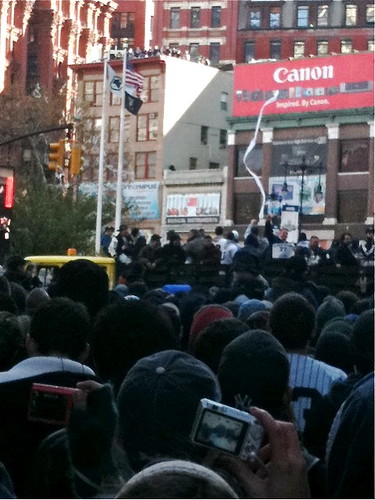
At the parade (it looks like I was far away, but not really--not!)
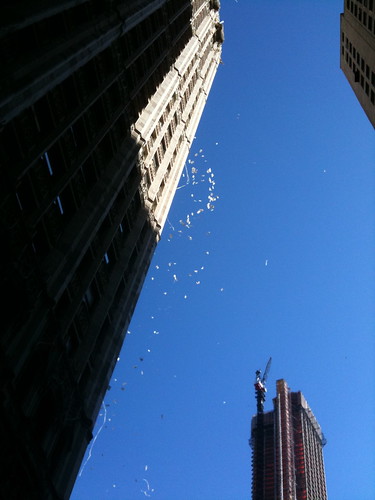
The confetti being dumped from the cornices--it turned out that some of the celebratory paper included people's vital records and bank documents. Oops!

New York's finest penning people in like cattle
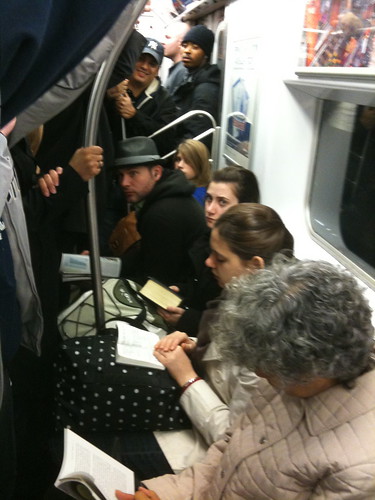
On a very crowded train--and the young woman in the middle of the photo was diligently reading and speaking her Hebrew text...only in New York!
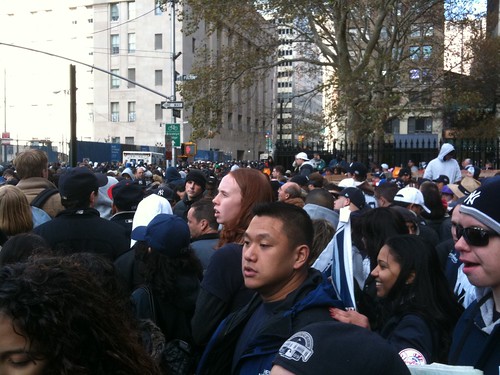
Among the many, the proud, the Yankees boosters
˚˚˚
Speaking of baseball, Chicago, blackness, racism, the not-so-proud, and so much more, I'll just present the photos. Ughhh and arrrgghhh. Sad and tragic doesn't barely scratch the surface.


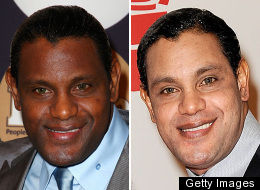
Vitiligo it ain't!
˚˚˚
On Thursday, playwright, novelist and activist Sarah Schulman will deliver the 18th Annual David R. Kessler Lecture. Her talk is entitled "Ties That Bind: Familial Homophobia and Its Consequences."
The event takes place at the CUNY Grad Center, at 34th St. and 5th Avenue, in Manhattan, in the Proshansky Auditorium. It runs from 6:30 to 8:30.
If you're in New York, don't miss it.
˚˚˚
The iPhone drawing continues. I'm addicted. I don't think I've drawn--or thumbed/index-fingered?--this much from life in many years. My new approach is to do as quick a sketch as possible, then fill in the details later. I've also been experimenting with different drawing styles, though I seem to be locked into train portraits these days.
I haven't yet figured out all the intricacies of the very popular Brushes program and have instead been using Autodesk Sketchbook for most of these portraits, which now total 23, or about 1 per day, though some days I do 2-3 in one shot. I do want to learn how to use the layers function in the former app, because I love Jorge Colombo's images.
Now if only AT&T would provide service anywhere near equal to the performance of my iPhone's apps, I'd consider the device essentially miraculous.
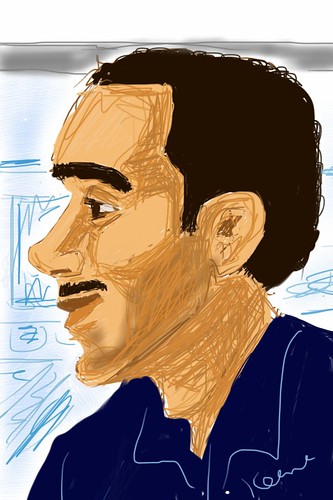
Man on light rail train

Woman on PATH

PATH conductor
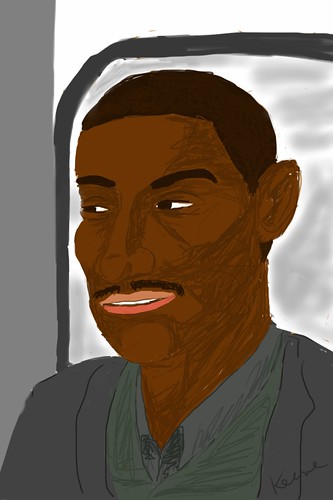
Man on light rail

Man on PATH
Tuesday, November 3, 2009
Elections Today + Congrats & RIPs + Lee Trains It + iSketches
I felt he was the best of the three major choices, none of which was appealing; though he's been lackluster at governing, he is a committed social, political and ideological progressive, and his few legislative successes have come in this area. In terms of lowering the state's grotesquely high property taxes, he's failed miserably. He's also presided over--but not been linked to--the usual intractable corruption that has historically been endemic to New Jersey. Earlier this year a slew of local Democrats, and one Republican, were caught in a massive crime dragnet; a number of people here in Hudson County, including several people in and around Jersey City's mayor, were indicted, while Hoboken's newly elected mayor, as well as the mayor of Secaucus, were also forced to resign after bribery charges. The global economic collapse hasn't helped him either, though I see little sign that he's doing much to address it other than tacking close to President Obama's coattails. And Obama was here repeatedly, including just this past weekend, again.
But I doubt people in the counties Corzine needs to win heavily (northeastern and far southwestern New Jersey) are going to turn out as much as the middle-belt counties, which are more Republican. I also imagine that many suburbanites assume Christopher J. Christie, the Republican candidate, a Karl Rove protegé and W Bush US Attorney appointee who has been dogged by allegations of misuse of his office and repeated ethics problems, will be as socially liberal as New Jersey's last Republican governor, Christine Todd Whitman, who also turned out to be fiscally irresponsible, in typical late 20th-century fashion. She slashed taxes whenever possible, privatized as much as she could get her hands on and borrowed heavily, leaving the state in the woeful condition it's been in throughout the early years of this century. If he wins Christie will probably reprise this record, with th
The third major candidate, independent Chris Daggett, has offered some interesting proposals, and probably would have gotten my vote if I'd had any confidence that he could move his proposals through the legislature. So it was Corzine, who appears to be losing to Christie as I type this. Voter turnout in Hudson and Essex Counties, two in which Corzine needs to win big, appears to be tepid.
Update: Christie has won and is the Governor-elect of New Jersey. He received 1,132,689 votes, or 49% of the total, to Corzine's 1,026,899, or 44%. Daggett, the 3rd party candidate, received 132,181, or 6%. One wonders had he not been in the race whether Corzine would have eked out a victory?
Across the river in Manhattan, Democrat Bill Thompson, is running against Goliath himself, Republican-turned-Independent Michael Bloomberg. In addition to negotiating with the City Council to repeal the term limits law to give himself another four years, Bloomberg is spending somewhere near $100 million to return to office. And for what? To serve as a caretaker for a city that is visibly falling apart, with rising numbers of homeless families, empty storefronts, and crumbling infrastructure, after having spent 8 years trying to remake Manhattan into a playground for the super-rich, and before that catering to ? This is a record to run on? Were he running against any other Republican, I think Thompson could have won on the merits of his record as head of the Board of Education and NYC Comptroller, which Bloomberg and even New York's previous GOP mayor, the odious Rudy Giuliani, have praised. It does look like Bloomberg will win, but I am praying that the election is closer than anyone expected. I can say with certainty that John Liu will be New York City's next Comptroller.
BTW, it looks like the Thompson-Bloomberg race is closer than anyone thought. As of now--10:30 pm--it's Thompson 48%, Bloomberg 49%...
Update: Bloomberg has won, 51%-46% over Thompson. 50,000 votes separated them; only a little over 1.1 million people voted, out of possibly 4 million. Disgusting.
In the Virginia race, it looks like crypto-extreme right-wing Catholic Republican Bob McDonnell, who wrote a graduate dissertation decrying will defeat hapless Democrat Creigh Deeds, who initially ran away from President Obama to the middle and, it appears, right into the Chesapeake. As a former Virginia resident and voter, I'm not surprised; the state's voting trends concerning the governor's seat seem to swing from far right to moderate left, though never too far from the ideologically conservative vein. As I type this, McDonnell's victory is already being stated as fact.
Maine voters go to the polls today to decide whether to preserve equal rights for same-sex marriage; voters will have the option to ratify the legislature's and governor's passage of same-sex marriage, or to overturn the legislative decision. I think it's unfortunately going to be very close, but I'm hoping that despite the Roman Catholic Church's intervention, No on 1--to preserve marriage equality--will win out.
Update: Right now, the Yes on 1 is winning by a slender margin...
Lastly, two legislative races are unfolding today, though only one has gotten real attention. In New York's 23rd House district, moderate Democrat Bill Owens was facing RNC-vetted and socially liberal Republican Dede Scozzafava (a last name worthy of fictional treatment), until right-wing teabagger Republicans and libertarians decided to throw their support to Doug Hoffman, who'd gotten New York State's Conservative Party's support. This led a slew of high profile right wingers, including Sarah Palin and Glenn Beck, to support Hoffman, sidelining Scozzafava, who withdrew and, in a mild shocker, threw her support to Owens. Though the district went for President Obama last year, it had not elected a Democrat to Congress since the 19th century! I am hoping Owens wins, just because it will throw water on some of the more ridiculous MCM punditry out there, which is casting every outcome unfavorable to Democrats as a referendum on the President, when it appears that local issues and the larger economic crisis, which the MCM has yet to address with any seriousness, are underlining today's voting trends. Speaking of local issues and important votes, California also has a special election today: John Garamendi, a progressive Democrat, is expected to replace Ellen Tauscher, a Conservadem, with ease, in a district that had been Republican since...the 19th century! Have you heard the pundits talk about this?
‹‹››
Although I tweeted about all of these congratulations in real time (i.e., last week), let me congratulate once again all the recent recipients of Mrs. Giles Whiting Foundation Awards, including Professor Jericho Brown, a CC grad who was honored for his amazing poetry. Congratulations, Jericho!
 Congratulations also go to prolific novelist Marie NDiaye, 42, who yesterday became the first black woman to win France's most prestigious literary prize, the Prix Goncourt. NDiaye (at right, www.frenchculture.org/), living in exile of Berlin because of the conservative rule of Nicolas Sarkozy and his party, published her first book at age 17 and received the Goncourt Prize for Trois Femmes Puissantes (Three Powerful Women). Félicitations à Marie NDiaye.
Congratulations also go to prolific novelist Marie NDiaye, 42, who yesterday became the first black woman to win France's most prestigious literary prize, the Prix Goncourt. NDiaye (at right, www.frenchculture.org/), living in exile of Berlin because of the conservative rule of Nicolas Sarkozy and his party, published her first book at age 17 and received the Goncourt Prize for Trois Femmes Puissantes (Three Powerful Women). Félicitations à Marie NDiaye.Yesterday, two intellectual giants passed away: pioneering (post-)structuralist anthropologist and intellectual Claude Lévi-Strauss and anti-Francoite novelist and philosopher Francisco Ayala. Over the last few weeks, the world has also lost photographer Roy DeCarava, whose collaboration with Langston Hughes, Sweet Flypaper of Life, is one of my great inspirations; feminist artist extraordinaire Nancy Spero; Professor Ray Browne, the founder of pop-culture studies; Raymond Federman, one of the giants of experimental American lit, especially "surfiction," during my college years and before; and fashion photographer Irving Penn, among others.
‹‹››
 They are perhaps the best known song lyrics about a US city to appear in a movie. The movie was On the Town. It hit screens in 1949, was written by Betty Comden and Adolph Green, and directed by Stanley Donen and Gene Kelly, who was one of its stars, along with "Old Blue Eyes," Frank Sinatra, and danceuse Ann Miller. The following four lines are unforgettable and, to anyone who's ever visited Manhattan and gotten lost, invaluable.
They are perhaps the best known song lyrics about a US city to appear in a movie. The movie was On the Town. It hit screens in 1949, was written by Betty Comden and Adolph Green, and directed by Stanley Donen and Gene Kelly, who was one of its stars, along with "Old Blue Eyes," Frank Sinatra, and danceuse Ann Miller. The following four lines are unforgettable and, to anyone who's ever visited Manhattan and gotten lost, invaluable."New York, New York, a wonderful town,
The Bronx is up and the Battery's down,
People ride around in a hole in the ground,
New York, New York, it's a wonderful town."
And Philadelphia Phillies pitcher Cliff Lee, it turns out, took them to heart. After getting stuck in traffic in Harlem (Morningside Heights) during his taxi ride to the stadium, he hopped on the subway, switched trains at one point, and arrived with a good amount of time to spare to pitch and win the opening game last week against CC Sabathia and the New York Yankees. I can imagine they probably wish he'd been one of the fearful types who wouldn't deign to set foot underground.
‹‹››
And I've kept on iDoodling, or is it iSketching? It's addictive. I think I'm up to about 1 a day at least. Are these copyrighted terms yet? A few more, all drawn on the iPhone, with thumbs and fingers:




